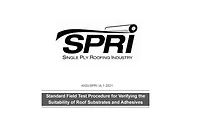SPRI to Revise and Re-Canvass Two ANSI Documents
SPRI, the association representing sheet membrane and component suppliers to the commercial roofing industry, announced that it is revising ANSI/SPRI FX-1 “Standard Field Test Procedure for Determining the Withdrawal Resistance of Roofing Fasteners” and plans to canvass the document for re-approval as an American National Standard.
WALTHAM, Mass. - SPRI, the association representing sheet membrane and component suppliers to the commercial roofing industry, announced that it is revising ANSI/SPRI FX-1 “Standard Field Test Procedure for Determining the Withdrawal Resistance of Roofing Fasteners” and plans to canvass the document for re-approval as an American National Standard.
SPRI developed this standard for measuring the pullout resistance of roofing fasteners in field conditions. Specifically, it is used to obtain data used by roofing professionals to calculate the proper density and placement of roofing fasteners used in membrane roofing systems and by roofing installers and inspectors as a quality control test to ensure that sufficient pullout performance is achieved. It was first approved in 1996 and revised and re-approved again in 2001 and 2006 in accordance with ANSI’s five-year renewal requirement.
In addition, SPRI will be updating ANSI/SPRI WD-1 2008 “Wind Design Standard Practice for Roofing Assemblies” to reflect the updates made to the recently published American Society of Civil Engineers (ASCE) 7-10 document, “Minimum Design Loads for Buildings and Other Structures.” These revisions will affect every roofing professional who uses ASCE for determining wind loads on structures. Some of the updates include the determination of the basic wind speed using new wind speed maps, changes to the exposure categories of buildings, as well as “simplified” procedures for determining wind pressures for buildings (as tall as 160 feet using tables.
ANSI/SPRI WD-1 2008 was developed with support from several roofing industry partners to help roof designers select an appropriate roofing system assembly for a specific building. It provides a two-part methodology of designing for wind uplift resistance of non-ballasted built-up, modified bitumen, and single-ply roofing system assemblies installed over any type of roof deck. (Refer to the ANSI/SPRI RP-4 Standard for wind design requirements of ballasted single-ply roofing systems).
“ANSI/SPRI WD-1 has always been an excellent tool to assist architects and consultants with the design and installation of roof systems that are compliant with the wind resistance requirements of the International Building Code (IBC),” said SPRI Technical Director Mike Ennis. “However, the easy-to-read tables and other pertinent data in WD-1 must be updated to comply with the new calculations contained in ASCE-7, as required by the IBC.”
Those wishing to participate in the canvassing process for these two documents should contact SPRI at info@spri.org.
WALTHAM, Mass. - SPRI, the association representing sheet membrane and component suppliers to the commercial roofing industry, announced that it is revising ANSI/SPRI FX-1 “Standard Field Test Procedure for Determining the Withdrawal Resistance of Roofing Fasteners” and plans to canvass the document for re-approval as an American National Standard.
SPRI developed this standard for measuring the pullout resistance of roofing fasteners in field conditions. Specifically, it is used to obtain data used by roofing professionals to calculate the proper density and placement of roofing fasteners used in membrane roofing systems and by roofing installers and inspectors as a quality control test to ensure that sufficient pullout performance is achieved. It was first approved in 1996 and revised and re-approved again in 2001 and 2006 in accordance with ANSI’s five-year renewal requirement.
In addition, SPRI will be updating ANSI/SPRI WD-1 2008 “Wind Design Standard Practice for Roofing Assemblies” to reflect the updates made to the recently published American Society of Civil Engineers (ASCE) 7-10 document, “Minimum Design Loads for Buildings and Other Structures.” These revisions will affect every roofing professional who uses ASCE for determining wind loads on structures. Some of the updates include the determination of the basic wind speed using new wind speed maps, changes to the exposure categories of buildings, as well as “simplified” procedures for determining wind pressures for buildings (as tall as 160 feet using tables.
ANSI/SPRI WD-1 2008 was developed with support from several roofing industry partners to help roof designers select an appropriate roofing system assembly for a specific building. It provides a two-part methodology of designing for wind uplift resistance of non-ballasted built-up, modified bitumen, and single-ply roofing system assemblies installed over any type of roof deck. (Refer to the ANSI/SPRI RP-4 Standard for wind design requirements of ballasted single-ply roofing systems).
“ANSI/SPRI WD-1 has always been an excellent tool to assist architects and consultants with the design and installation of roof systems that are compliant with the wind resistance requirements of the International Building Code (IBC),” said SPRI Technical Director Mike Ennis. “However, the easy-to-read tables and other pertinent data in WD-1 must be updated to comply with the new calculations contained in ASCE-7, as required by the IBC.”
Those wishing to participate in the canvassing process for these two documents should contact SPRI at info@spri.org.
Looking for a reprint of this article?
From high-res PDFs to custom plaques, order your copy today!






